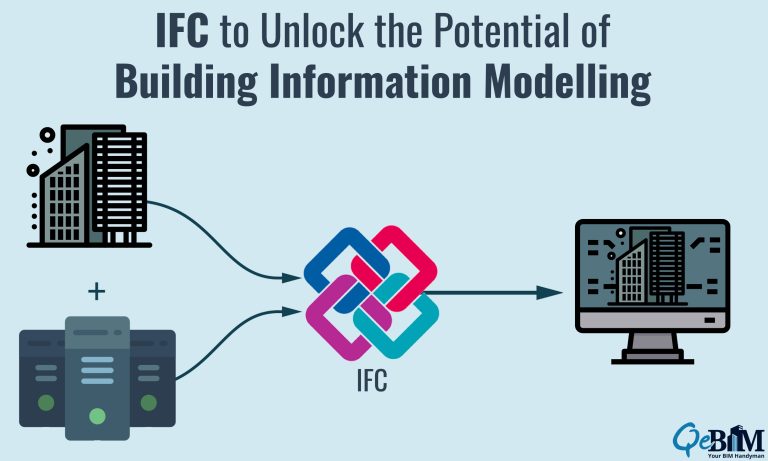IFC to Unlock the Potential of Building Information Modelling

Introduction
The introduction of Building Information Modelling (BIM) has transformed the construction business. BIM is the process of creating a computerized model of a construction or infrastructure venture that allows everyone involved in the project to collaborate in a simulated setting. The International Foundation Classes (IFC) constitute an essential component of BIM, enabling compatibility among various software systems utilized by the building sector. In this essay, we will look at the IFC idea as well as its importance in the construction business.
What exactly are International Foundation Classes?
International Foundation Classes (IFC) are a standardized model of data utilized to digitally define the complete building or infrastructure project. The representation includes information regarding the project’s physical characteristics including geometry, spatial relationships, and material attributes.
It additionally contains details about the project’s practical characteristics, including its intended purpose, structural behavior, or impact on the environment. The International Organisation for Standardisation (ISO) and the International Electrotechnical Commission (IEC) developed and still uphold the IFC open standard.
IFC is intended to serve as an extensible format, meaning its intended use might be utilized through a variety of software applications and systems. This can be significant since building projects include numerous stakeholders, every one of which may utilize an alternate software tool to complete their respective duties.
Architects, for instance, might utilize one software program to create the building, whereas engineering professionals might utilize a different tool to do calculations. IFC makes sure these instruments may share information alongside one another neither missing any data nor jeopardizing the undertaking’s integrity.
IFC utilizes a hierarchical data model, meaning it organizes information in the shape of a tree. The framework is made up of items that can be identified by their characteristics and relations to other objects. Each item has an identification number that is utilized across the manufacturing process to identify it. The items might be classified into classes that indicate different kinds of objects. These include, for instance walls, doors, windows, as well as ceilings.
The Advantages of IFC
The IFC provides various advantages to the construction industry, including:
Improved Collaboration: IFC allows all project stakeholders to collaborate in a remote environment. This implies that architects, engineers, contractors, and owners will all have possession of the same data and may collaborate to produce the most effective design possible.
- Increased Efficiency: By seamlessly transmitting data amongst multiple software programs, IFC removes the requirement for entering information manually and decreases errors. Which minimizes time as well as decreases the possibility of errors.
- Better Communication: IFC fosters interaction among software programs by guaranteeing that information may be exchanged effortlessly. This implies that stakeholders can interact more effectively with one another, minimizing misconceptions and boosting the project as a whole quality.
- Improved Visualisation: IFC allows stakeholders to see the entire endeavor in 3D. This enables companies to spot potential issues and implement modifications when building starts off, lowering the likelihood of expensive mistakes.
- Enhanced Data Management: IFC offers a standardized format for information that makes it simple to organize and distribute data. These guarantees ensure everyone involved in the project has possession of the exact same data, lowering the chance of misconceptions and enhancing the project’s overall quality.
IFC in Action
IFC is frequently utilized throughout the construction sector, especially for massive operations infrastructure projects like airports, hospitals, and stadiums. It’s additionally employed in smaller endeavors like residential and commercial construction.
The construction of the landmark Shanghai Tower in China is a prime instance of IFC utilization. The skyscraper has a height of 632 meters and 128 stories. This was constructed utilizing BIM Company, with IFC as the preferred format for data. This allowed the various project stakeholders to communicate effectively as well as assure the completed skyscraper was built to the highest possible specifications.
The International Foundation Classes (IFC) are an essential component of Building Information Modelling (BIM) and serve a significant role in maintaining compatibility across various software systems used in the construction sector. The IFC data model represents a standardized data model that allows everyone involved in the project to collaborate in a virtual setting. It offers a data hierarchy that organizes information into a structure resembling a tree for straightforward administration and sharing.
Conclusion
IFC aids the construction sector by improving collaboration, increasing efficiency, improving communication, improving visualization, and improving data management. It is widely employed in massive construction projects as well as smaller endeavors like residential and commercial buildings.
Finally, IFC is an important component of BIM Services that serves a significant part of the construction sector. Its standardization through accessibility characteristics has significantly boosted stakeholder interaction and cooperation, resulting in superior project results. When the construction sector evolves, the utilization of IFC will probably grow progressively more common, improving the efficiency and effectiveness of building projects.